[Solved]: Can't Shrink Partitions in Windows 10
Many users face this common issue "can't shrink partition Windows 10," when trying to resize partition size using Disk Management. But don’t worry! In this article, we will explore the reasons behind this issue and offer effective solutions to successfully shrink a partition in Windows 10.
Why can't I shrink partitions in Windows 10?
Shrinking a partition through Disk Management seems like an easy task, but many users face the frustrating issue of "can't shrink partition Windows 10." This problem can arise for various reasons. Here are some common ones you should know:
☛ You can't shrink a Windows partition if there is no enough space available on the disks.
☛ Unmovable files are typically located at the end of the volume prevent it from being shrunk.
☛ Sometimes, file system errors can also make a volume or partition inaccessible or invisible.
☛ Lastly, Disk Management can only resize NTFS partitions, not FAT32 partitions. If your partition is formatted as FAT32, you may need to use other tools to resize it.
How to fix can't shrink partition Windows 10?
Fix 1. Disable the Unmovable Files
Unmovable system files are often located at the end of the partition, making it hard for the operating system to shrink the partition from the end. In such cases, you can manually disable these files:
➤ Disable System Protection:
- Press Win + R, type SystemPropertiesProtection.exe, and press Enter.
- Click on the C drive, select Disable system protection, then click Apply and Yes.
- Restart your computer.
➤ Disable Hibernation:
- Click Start, type CMD in the search box, right-click cmd, and choose Run as administrator.
- Type powercfg.exe /hibernate off and press Enter.
- Restart your computer.
➤ Disable Page Files:
- Press Win + R, type SystemPropertiesPerformance.exe, and press Enter.
- Click on the Advanced tab, then click Change under Virtual Memory.
- Uncheck Automatically manage paging file size for all drives, click Set > OK.
- Restart your computer.
➤ Disable Kernel Memory Dump:
- Click Start, select Control Panel, then click System and Security.
- Click Settings under Startup and Recovery, and change the Write debugging information dropdown menu to None.
- Restart your computer.
Fix 2. Use An Alternative Tool to Shrink Partitions in Windows 10
As mentioned earlier, Disk Management only supports shrinking NTFS partitions, not FAT32 partitions. If your partition is formatted as FAT32, you'll need to use alternative tools to resize it. We recommend AOMEI Partition Assistant, a powerful disk management and partition software for Windows 11, 10, 8.1, 8, and 7. Unlike Disk Management, AOMEI Partition Assistant offers a safer and more flexible way to resize partitions. With just one click, you can easily adjust partition sizes to meet your needs.
Additionally, AOMEI Partition Assistant includes various features, such as resizing partitions using non-adjacent unallocated space and effortlessly managing encrypted partitions, making disk management easier than ever before.
If you can't shrink partitions in Windows 10 properly, try using AOMEI Partition Assistant to do it again:
Step 1. Download and install AOMEI Partition Assistant on your device. Launch the software, right-click the partition you want to shrink, and select the 1-Click Adjust Space option.
Step 2. To shrink a partition without losing data, simply drag the dot at the beginning or end. For example, if you want to reduce the F: partition, drag the dot to the right. This action will shrink the F: partition and enlarge the D: partition simultaneously. Then, click OK to proceed.
Alternatively, you can drag the dot near the partition C: tail forward to shrink the partition C: so the D: will also be enlarged with the space of C: at the same time.
Step 3. After setting the desired adjustments, preview the changes in the Pending Operations window. Then click Apply > Proceed to confirm and apply the changes.
Step 4. Wait for the operation to be finished. It may take a few minutes. Once complete, the partition sizes will have been adjusted accordingly.
Fix 3. Check File System Errors on Disks
Sometimes, you may not be able to shrink a partition in Windows 10 due to file system errors on your disk. Don't worry! You can follow these steps to check and repair these errors:
Step 1. Right-click on the drive or partition, which can't be shrunk in Windows 10.
Step 2. Select the Properties option from the context menu.
Step 3. Go to the Tools tab, and click the Check button. Then wait for the process to complete. If any errors are found, Windows will prompt you to repair them.
If this method fails to resolve your issue, consider using AOMEI Partition Assistant. This reliable software can help you easily check for bad sectors, detect partitions, and fix other common errors. Alternatively, you can directly replace the failed disk by using the Clone feature within this tool.
Fix 4. Free up Disk Space
If you encounter the error message "There is not enough space available on the disk(s) to complete this operation," it means you need to free up disk space. You can do this by deleting unnecessary files, uninstalling unused programs, or moving data to another drive. AOMEI Partition Assistant offers many practical features to assist you in freeing up disk space for future use, including Allocate Free Space, APP Mover, and more.
Frequently Asked Questions
Q1: Why can unmovable files prevent partition shrinking?
These files are critical for system operation and cannot be moved without affecting the integrity of the data and system processes. When you try to shrink a partition through Disk Management, these files cannot be moved automatically.
Q2: Does shrinking a partition delete data?
No, shrinking a partition typically only reduces its size, leaving the data stored on it intact. However, there are risks involved, especially if the operation is interrupted or not done correctly.
Q3: How can I shrink a partition without losing data?
We recommend using trusted third-party software like AOMEI Partition Assistant to perform partition resizing. However, it’s always recommended to back up your data before making any changes to disk partitions.
Conclusion
The "can't shrink partition in Windows 10" issue can arise for various reasons. This post provides four practical solutions to help you successfully shrink partitions. We highly recommend AOMEI Partition Assistant, which simplifies disk management and optimizes device performance.


